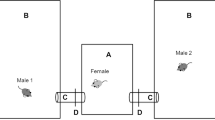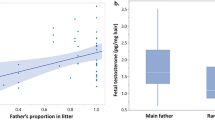Abstract
MALES of most animal species will enhance their reproductive success if they mate often and with many different partners, whereas promiscuous mating is unlikely to increase a female's reproductive success. Why then is multiple copulation by females so common1–6? Many theoreticians have suggested that multiple copulations might enhance the viability of a female's offspring, either because of inadequate quantities of sperm from the first mating1,7, additional nutrients derived from the seminal fluid7,8 or some genetic advantage9–14. Our field studies on Swedish adders provide the first empirical evidence that multiple copulations, with different partners each time, increase offspring viability. This advantage apparently results from more intense sperm competition in the female's reproductive tract, resulting in a higher proportion of her ova being fertilized by genetically superior males.
This is a preview of subscription content, access via your institution
Access options
Subscribe to this journal
Receive 51 print issues and online access
$199.00 per year
only $3.90 per issue
Buy this article
- Purchase on Springer Link
- Instant access to full article PDF
Prices may be subject to local taxes which are calculated during checkout
Similar content being viewed by others
References
Drummond, B. A. III In Sperm Competition and the Evolution of Animal Mating Systems (ed. Smith, R. L.) 291–370 (Academic, Orlando, Florida, 1984).
Hrdy, S. B. in Feminist Approaches to Science (ed. Bleier, R.) 119–146 (Pergamon. Oxford. 1986).
Manhagen, C. Trends Ecol. Evol. 6, 183–186 (1991).
Bateman, A. J. Heredity 2, 349–368 (1948).
Williams, G. C. Adaptation and Natural Selection: a Critique of Some Current Evolutionary Thought (Princeton University Press, New Jersey, 1966).
Trivers, R. L. in Sexual Selection and the Descent of Man (ed. Campbell, B.) 136–179 (Aldine, Chicago, 1972).
Ridley, M. Biol. Rev. 63, 509–549 (1988).
Turner, M. E. & Anderson, W. W. Evolution 37, 714–723 (1983).
Parker, G. A. Biol. Rev. 45, 525–567 (1970).
Davies, E. M. & Boersma, P. D. Am. Nat. 123, 594–611 (1984).
Stacey, P. B. Am. Nat. 120, 51–64 (1982).
Devine, M. C. in Sperm Competition and the Evolution of animal Mating Systems (ed. Smith, R. L.) 509–521 (Academic, Orlando, Florida, 1984).
Parker, G. A. in Sperm Competition and the Evolution of Animal Mating Systems (ed. Smith, R. L.) 1–60 (Academic, Orlando, Florida, 1984).
Loman, J., Madsen, T. & Håkansson, T. Oikos 52, 69–72 (1988).
Shine, R. in Biology of the Reptilia Vol. 16 (eds Gans, C. & Huey, R. B.) 275–330 (Liss, New York, 1988).
Saint Girons, H. & Kramer, E. Revue suisse Zool. 70, 191–221 (1963).
Nilson, G. Amphibia-Reptilia 2, 63–82 (1981).
Stille, B., Madsen, T. & Nikiasson, M. Oikos 47, 173–175 (1986).
Maynard Smith, J. The Evolution of Sex (Cambridge University Press, Cambridge, 1978).
Madsen, T. & Shine, R. Evolution (in the press).
Rails, K., Brugger, K. & Ballou, J. Science 206, 1101–1103 (1979).
Author information
Authors and Affiliations
Rights and permissions
About this article
Cite this article
Madsen, T., Shine, R., Loman, J. et al. Why do female adders copulate so frequently?. Nature 355, 440–441 (1992). https://doi.org/10.1038/355440a0
Received:
Accepted:
Issue Date:
DOI: https://doi.org/10.1038/355440a0
This article is cited by
-
Polyandry and non-random fertilisation maintain long-term genetic diversity in an isolated island population of adders (Vipera berus)
Heredity (2023)
-
Unique sperm haplotypes are associated with phenotypically different sperm subpopulations in Astyanax fish
BMC Biology (2018)
-
Forced monogamy in a multiply mating species does not impede colonisation success
BMC Ecology (2014)
-
DNA fingerprinting in zoology: past, present, future
Investigative Genetics (2014)
-
Parentage analyses suggest female promiscuity and a disadvantage for athletic males in the colour-polymorphic lizard Podarcis melisellensis
Behavioral Ecology and Sociobiology (2014)
Comments
By submitting a comment you agree to abide by our Terms and Community Guidelines. If you find something abusive or that does not comply with our terms or guidelines please flag it as inappropriate.



